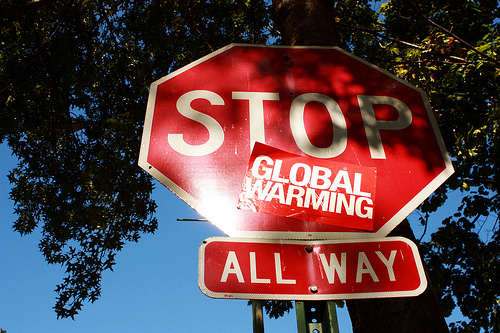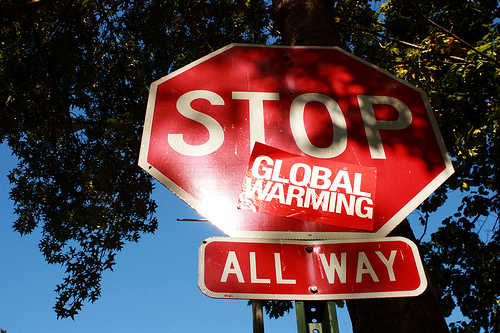 No more waiting at the stop sign. It’s time to get moving!Photo courtesy of katiecampbell via flickr
No more waiting at the stop sign. It’s time to get moving!Photo courtesy of katiecampbell via flickr
We now know the U.S. Senate will not pass climate-change legislation this year. Postmortems have pointed to a number of challenges: the lack of leadership from the White House, unified GOP opposition to the Senate cap-and-trade bill, the structure and rules of the Senate, and the complicated nature of cap-and-trade legislation.
There has been one major omission in much of this analysis: the absence of pressure from Americans across the country demanding that serious action be taken to address climate change. Few Americans are currently engaged in this great societal challenge in a way that would generate the necessary political will to act. It is the absence of this public pressure, above all else, that has resulted in the current state of political inaction.
Take the most broadly transformational political acts in the history of the U.S. — the signing of the Emancipation Proclamation and the approval of the 14th Amendment in the 1860s, women’s suffrage in 1920, the Civil Rights Act and Voting Rights Act of the mid-1960s, the establishment of the EPA and the Clean Water Act and Clean Air Act in the early 1970s, to name a few. They all required some form of political leadership, but that leadership was exercised in response to the abolitionist, women’s suffrage, civil rights, and environmental movements of the time, social movements that forced the issues into our national conscience and made inaction politically untenable. These social movements consisted of large numbers of people, united by a strong sense of shared values and moral purpose, who stood up to the deeply held assumptions and powerful vested interests of their times.
Environmental organizations and foundations spent well over $200 million in the attempt to enact climate change legislation. Several of these organizations built alliances with some of the largest corporations in America in an effort to promote a watered-down bill. And even this effort failed. Why?
The top answer is that we failed to build a social movement equal to the task. In the absence of a real climate movement, we are likely to continue to see even inadequate half-measures fail again and again. Only a broad-based social movement around climate change can get the job done, fueled by the same passion and underpinned with the same moral conviction that characterized the historical movements that ended slavery, promoted suffrage, secured civil rights, and mandated a cleaner and healthier environment.
Some say that climate change is different in kind from earlier injustices because it is harder to understand. The concept that the earth’s climate is being changed by human activity is too unlikely, too intangible. Because the effects are not immediate or even visible to most people, it is difficult to create a sense of urgency. Perhaps.
But there are also many similarities between climate change and other great moral injustices of our nation’s past. All important social movements in this country have overcome daunting obstacles. And all of these movements have shared a few fundamental building blocks, which climate activists need to learn from and emulate.
What would a strong, vibrant American climate movement look like?
One: A climate movement must, in the tradition of all social movements, be rooted in a powerful story, a passionate narrative about the threat to the world we are bequeathing to our children, and our obligation to take some responsibility for that world.
Social movements are about people and their values and threats to those values. We have become so accustomed to relying on polling data and messaging experts to tell us how to sell our ideas to the public that we have lost faith in our ability to consider why we care and to tell a simple, motivating story about why others must care too. It is the compelling nature of the tragedy unfolding that then can lead to adequate policy prescriptions and strategies to implement them.
Two: We need to identify the passion that already exists in individuals and groups across the country, and help translate that passion into collective action. The goal is to have a diversity of efforts of people working in their communities that are all ultimately tied together by a national strategy.
Three: We need to invest in building leadership teams at the local, state, and national levels that allow for creativity and accountability and, ultimately, that inspire and support the involvement of large numbers of people. This is the only way to engage a broad swath of our nation, from students and parents to religious communities and union workers and environmental activists.
Can we build a climate movement that trains thousands of leaders to organize activists? That encourages specific direct actions that confront our nation’s leaders with the need to make a choice about the future? That shows that inaction is simply intolerable? American history suggests that the answer is yes, but we won’t know until we try. The time to take this to the next level is now.
Editor’s note: Kelsey Wirth is on Grist’s board of directors.



